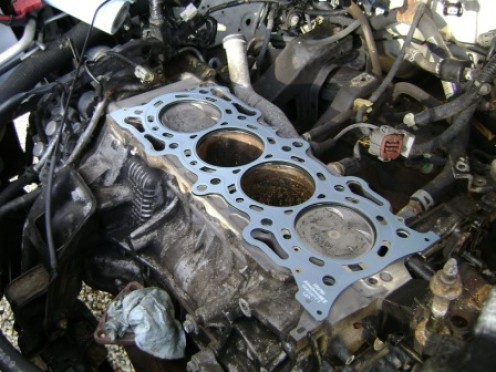The head gasket is a vital part of any vehicle’s engine. It seals the cylinder head (which houses the engine valves) to the engine block (which houses the pistons and crankshaft). Head gasket leaks can range in severity. Minor leaks can simply cause the engine to consume extra oil or coolant. More severe leaks can result in coolant and oil mixing (causing loss of lubrication in the crankcase) or complete loss of compression (causing severe problems with drivability).
A car that is running poorly without an apparent explanation might have a blown head gasket, and should be checked for this common problem. There are a few warning signs pointing to a blown head gasket. Any car exhibiting these symptoms should be run through a compression test to check the integrity of the head gasket.
Coolant Consumption
There are literally dozens of coolant passages in the cylinder head of a modern car. Coolant flows through these passages to pull excess heat out of the engine. The head gasket seals these passages to keep the coolant from running out of the passages into the combustion chambers of the engine. A ruptured head gasket can let coolant leak into the cylinders, causing the engine to consume coolant. To check for a blown head gasket, first look at the exhaust pipe with the engine hot and the car running. Is there excess steam or water dripping from the exhaust? Put your hand in front of the exhaust outlet. Does the exhaust seem wet or steamy? Next, check under the hood with the engine running. Look at the coolant reservoir. Look for bubbles from the engine inlet. Any of these could be signs of a blown head gasket.
Oil Consumption
There are just as many oil passages in the cylinder head as there are coolant passages. Oil passages are cast into the cylinder to transport and return oil to and from the valve train. The head gasket seals these passages as oil moves between the engine block and the cylinder head. Excessive consumption of oil can be caused by a rupture in the head gasket. Oil consumption can be caused by other things (like worn piston rings) but if your car is going through too much oil, a blown head gasket could be the culprit. An engine that is burning too much oil will idle poorly and have bluish-white exhaust. If your car is exhibiting these symptoms, it should be checked for a blown head gasket.
Oil Mixing With Coolant
A dangerous symptom of a blown head gasket is the mixing of oil and coolant. If coolant is mixing into the engine’s oil supply, this can be very detrimental to the lubricating properties of the engine oil. It can cause damage to engine bearings and other parts of the engine. Check the engine’s oil dipstick. Brown, bubbly oil or any inconsistencies or traces of water on the dipstick can be symptoms of a severe head gasket failure. Have the car’s engine checked right away.







